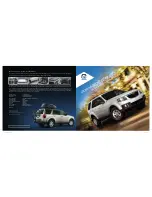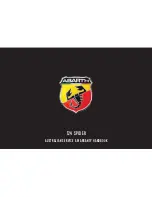
03 Your driving environment
Foot brake
03
118
General
The car is equipped with two brake circuits. If
one brake circuit is damaged then this will
mean that the brakes engage at a deeper level
and harder pressure on the pedal is needed to
produce the normal braking effect.
The driver's brake pedal pressure is assisted
by a brake servo.
WARNING
The brake servo only works when the engine
is running.
If the brake is used when the engine is switched
off then the pedal will feel stiff and more force
must be used to brake the car.
In very hilly terrain or when driving with a heavy
load the brakes can be relieved by using engine
braking. Engine braking is most efficiently used
if the same gear is used downhill as up.
For more general information on heavy loads
on the car, see page 300.
Anti-lock braking system
The car is equipped with ABS (Anti-lock
Braking System) which prevents the wheels
from locking during braking. This means the
ability to steer is maintained and it is easier to
swerve to avoid a hazard for example. Vibration
may be felt in the brake pedal when this is
engaged and this is normal.
A short test of the ABS system is made auto-
matically after the engine has been started
when the driver releases the brake pedal. A
further automatic test of the ABS system may
be made when the car reaches 40 km/h. The
test may be experienced as pulses in the brake
pedal.
Emergency brake lights and automatic
hazard warning flashers
Emergency brake lights are activated to alert
vehicles behind about sudden braking. The
function means that the brake light flashes
instead of - as in normal braking - shining with
a constant glow.
Emergency brake lights are activated at
speeds above 50 km/h if the ABS system is
working and/or in the event of sudden braking.
After the car's speed has been slowed below
10 km/h the brake light returns from flashing to
the normal constant glow - while at the same
time the hazard warning flashers are activated,
and they flash until the driver changes engine
speed with the accelerator pedal or they are
deactivated with their button, see page 85.
Cleaning the brake discs
Coatings of dirt and water on the brake discs
may result in delayed brake function. This delay
is minimised by cleaning the brake linings.
Manual cleaning is advisable with wet road sur-
faces, prior to long-stay parking and after the
car has been washed. Carry this out by braking
gently during a short period while en route.
Emergency Brake Assistance
Emergency Brake Assistance EBA (Emergency
Brake Assist) helps to increase brake force and
so reduce braking distance. EBA detects the
driver's braking style and increases brake force
as necessary. The brake force can be rein-
forced up to the level when the ABS system is
engaged. The EBA function is interrupted when
the pressure on the brake pedal is reduced.
NOTE
When EBA is activated the brake pedal low-
ers slightly more than usual, depress (hold)
the brake pedal as long as necessary. If the
brake pedal is released then all braking
ceases.
Summary of Contents for V70 SPORT
Page 1: ...VOLVO V70 XC70 Owners Manual Web Edition ...
Page 2: ......
Page 7: ...Table of contents 7 09 09 Alphabetical Index Alphabetical Index 318 ...
Page 13: ...Introduction Volvo and the environment 13 ...
Page 15: ...SAFETY ...
Page 41: ...01 Safety 01 41 ...
Page 43: ...LOCKS AND ALARM ...
Page 65: ...YOUR DRIVING ENVIRONMENT ...
Page 68: ...03 Your driving environment Instruments and controls 03 68 Right hand drive ...
Page 91: ...03 Your driving environment Lighting 03 91 Templates for halogen headlamps G021155 ...
Page 129: ...COMFORT AND DRIVING PLEASURE ...
Page 215: ...DURING YOUR JOURNEY ...
Page 239: ...05 During your journey 05 239 ...
Page 241: ...WHEELS AND TYRES ...
Page 255: ...MAINTENANCE AND SERVICE ...
Page 275: ...07 Maintenance and service Fuses 07 275 Engine compartment ...
Page 287: ...07 Maintenance and service 07 287 ...
Page 289: ...SPECIFICATIONS ...
Page 290: ...08 Specifications Type designations 08 290 Label location ...
Page 329: ......
Page 330: ...Kdakd 8Vg 8dgedgVi dc IE c a h 6I Eg ciZY c HlZYZc iZWdg 8deng i Kdakd 8Vg 8dgedgVi dc ...
















































